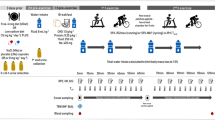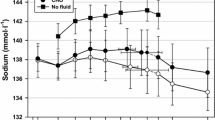Abstract
The purpose of this investigation was to examine the effect of low body glycogen stores on plasma ammonia concentration and sweat ammonia excretion during prolonged, nonexhausting exercise of moderate intensity. On two occasions seven healthy untrained men pedalled on a cycle ergometer for 60 min at 50% of their predetermined maximal O2 uptakes (\(\dot V{\text{O}}_{\text{2}} \) max) firstly, following 3 days on a normal mixed diet (N-diet) (60% carbohydrates, 25% fat and 15% protein) and secondly, following 3 days on a low-carbohydrate diet (LC-diet) (less than 5% carbohydrates, 50% fat and 45% protein) of equal energy content. Blood was collected from the antecubital vein immediately before, at 30th and at 60th min of exercise. Sweat was collected from the hypogastric region using gauze pads. It was shown that plasma ammonia concentrations after the LC-diet were higher than after the N-diet at both the 30th and 60th min of exercise. Sweat ammonia concentration and total ammonia loss through the sweat were also higher after the LC-diet. The higher ammonia concentrations in plasma and sweat after the LC-diet would seem to indicate an increased ammonia production, which may be related to reduced initial carbohydrate stores.
Similar content being viewed by others
References
Bergström J, Hermansen L, Hultman E, Saltin B (1967) Diet, muscle glycogen and physical performance. Acta Physiol Scand 71:140–150.
Broberg S, Sahlin K (1988) Hyperammonemia during prolonged exercise: an effect of glycogen depletion? J Appl Physiol 65:2475–2477.
Broberg S, Sahlin K (1989) Adenine nucleotide degradation in human skeletal muscle during prolonged exercise. J Appl Physiol 65:2475–2477.
Czarnowski D, Górski J (1991) Sweat ammonia excretion during submaximal cycling exercise. J Appl Physiol 70:371–374.
Czarnowski D, Górski J (1992) Plasma ammonia is the principal source of ammonia in sweat. Eur J Appl Physiol 65:135–137.
Da Fonseca-Wollheim F (1973) Direkte Plasmaammoniakbestimmung ohne Enteiweibung. Z. Klin Chem Klin Biochem 11:426–431.
Dohm GL (1986) Protein as a fuel for endurance exercise. In: Pandolf KB (ed) Exercise and sport sciences reviews, vol 14. Macmillan New York, pp. 143–174
Dudley GA, Terjung RL (1985a) Influence of aerobic metabolism on IMP accumulation in fast-twitch muscle. Am J Physiol 248:C37-C42.
Dudley GA, Terjung RL (1985b) Influence of acidosis on AMP deaminase activity in contracting fast-twitch muscle. Am J Physiol 248:C43-C50
Eriksson LS, Broberg S, Björkman O, Wahren J (1985) Ammonia metabolism during exercise in man. Clin Physiol 5:325–336.
Galbo H, Holst JJ, Christensen NJ, (1979) The effect of different diets and of insulin on the hormonal response to prolonged exercise. Acta Physiol Scand 107:19–32
Graham TE, Kiens B, Hargreaves M, Richter EA (1991) Influence of fatty acids on ammonia and amino acid flux from active human muscle. Am J Physiol 261:E168-E176
Greenhaff PJ, Gleeson M, Maughan RJ (1988) The effects of diet on muscle pH and metabolism during high intensity exercise. Eur J Appl Physiol 57:531–539
Greenhaff PL, Leiper JB, Ball D, Maughan RJ (1991) The influence of dietary manipulation on plasma ammonia accumulation during incremental exercise in man. Eur J Appl Physiol 63:338–344
Jansson E, Hjemdahl P, Kaijser L (1982) Diet induced changes in sympatho-adrenal activity during submaximal exercise in relation to substrate utilization in man. Acta Physiol Scand 114:171–178
Langfort J, Pilis W, Zarzeczny R, Nazar K, Kaciuba-Uścilko H, Titow-Stupnicka E, Wojtyna J (1993) Effect of ketogenic diet on metabolic and hormonal responses to graded exercise in men. In: XIX Congress of the Polish Physiological Society (Abstracts). Swiecka E (ed) N. Copernicus University, Toruń, p 362
Lemon PWR, Mullin JP (1980) Effect of initial muscle glycogen levels on protein catabolism during exercise. J Appl. Physiol 48:624–629
Lowenstein JM (1972) Ammonia production in muscle and other tissues: the purine nucleotide cycle. Physiol Rev 52:382–414
MacLean DA, Spriet LL. Hultman E, Graham TE (1991) Plasma and muscle amino acid and ammonia responses during prolonged exercise in humans. J Appl Physiol 70:2095–2103
Mutch BJC, Banister EW (1983) Ammonia metabolism in exercise and fatigue: a review. Med Sci Exerc 15:41–50
Noll F (1974) L-(+)-Lactate. Determination with LDH, GPT and NAD. In: Bergmeyer HU (ed) Methods of enzymatic analysis, 2nd ed. Academic Press, New York p 1475
Parnas JK (1929) Ammonia formation in muscle and its source. Am J Physiol 90:567–472
Sahlin K, Edström L, Sjöholm L, Hultman E (1981) Effect of lactic acid accumulation and ATP decrease on muscle tension and relaxation. Am J Physiol 240:C121-C126
Sahlin K, Katz A (1988) Purine nucleotide metabolism. Principles of exercise biochemistry. Med Sport Sci 27:120–139
Sahlin K, Katz A, Broberg S (1990) Tricarboxylic acid cycle intermediates in human muscle during prolonged exercise. Am J Physiol 259:C834-C841
Sahlin K, Palmskog G, Hultman EE (1978) Adenine nucleotide and IMP contents of the qudriceps muscle in man after exercise. Pflügers Arch 374:193–198
Spencer MK, Zhen Y, Katz A (1991) Carbohydrates supplementation attenuates IMP accumulation in human muscle during prolonged exercise. Am J Physiol 261:C71-C76
Stabenau JR, Warren KS, Rall DP (1959) The role of pH gradient in the distribution of ammonia between blood and cerebro-spinal fluid, brain and muscle. J. Clin Invest 38:373–383
Visek WJ (1968) Some aspects of ammonia toxicity in animal cells. J Dairy Sci 51:286–295
Wagenmakers AJM, Beckers EJ, Brouns F, Kuipers H, Soeters PB, Vusse GJ van der, Saris WHM (1991) Carbohydrate supplementation, glycogen depletion, and amino acid metabolism during exercise. Am J Physiol 260:E883-E890
Author information
Authors and Affiliations
Rights and permissions
About this article
Cite this article
Czarnowski, D., Langfort, J., Pilis, W. et al. Effect of a low-carbohydrate diet on plasma and sweat ammonia concentrations during prolonged nonexhausting exercise. Europ. J. Appl. Physiol. 70, 70–74 (1995). https://doi.org/10.1007/BF00601811
Accepted:
Issue Date:
DOI: https://doi.org/10.1007/BF00601811




